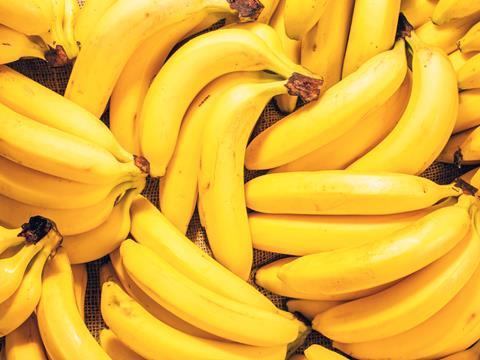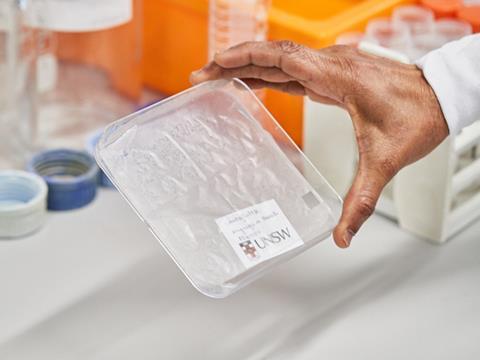
Researchers at the University of New South Wales have discovered a novel way to turn banana plantation waste into recyclable, biodegradable packaging material.
Over the past few months, Packaging Europe has been exploring innovative bio-based alternatives to single-use plastics – from spray-on edible peels to flexible films made from waste crustacean shells. Now, Australian scientists have made a discovery in this field that they believe could provide a sustainable packaging solution while at the same time preventing food waste.
Associate Professor Jayashree Arcot and Professor Martina Stenzel were looking for ways to convert agricultural waste into a useful product when the banana-growing industry came to their attention. According to A/Prof Arcot, in most cases, only 12% of the banana plant (the fruit) is actually used, with the rest being discarded post-harvest.
“What makes the banana-growing business particularly wasteful compared to other fruit crops is the fact that the plant dies after each harvest,” said A/Prof Arcot.
“We were particularly interested in the pseudostems – basically the layered, fleshy trunk of the plant which is cut down after each harvest and mostly discarded on the field. Some of it is used for textiles, some as compost, but other than that, it’s a huge waste,” she continued.
A/Prof Arcot and Prof Stenzel wondered whether the pseudostems would be valuable sources of cellulose – an important structural component of plant cell walls – that could be used in packaging, paper products, textiles and even medical applications such as wound healing and drug delivery.
“The pseudostem is 90% water, so the solid material ends up reducing down to about 10%,” A/Prof Arcot said. “We bring the pseudostem into the lab and chop it into pieces, dry it at very low temperatures in a drying oven, and then mill it into a very fine powder.”
Prof Stenzel continued: “We then take this powder and wash it with a very soft chemical treatment. This isolates what we call nano-cellulose which is a material of high value with a whole range of applications. One of those applications that interested us greatly was packaging, particularly single-use food packaging where so much ends up in landfill.”
When processed, the material reportedly has a consistency similar to baking paper.

A/Prof Arcot said depending on the intended thickness, the material could be used in a number of different formats in food packaging. “There are some options at this point, we could make a shopping bag, for example,” she said.
“Or depending on how we pour the material and how thick we make it; we could make the trays that you see for meat and fruit. Except of course, instead of being foam, it is a material that is completely non-toxic, biodegradable and recyclable.”
A/Prof Arcot said she and Prof Stenzel have confirmed in tests that the material breaks down organically after putting ‘films’ of the cellulose material in soil for six months. The results apparently showed that the sheets of cellulose were well on the way to disintegrating in the soil samples.
“The material is also recyclable. One of our Ph.D. students proved that we can recycle this three times without any change in properties,” Professor Arcot said.
Tests with food have also reportedly proved that the product poses no contamination risks.
“We tested the material with food samples to see whether there was any leaching into the cells,” Professor Stenzel said. “We didn’t see any of that. I also tested it on mammalian cells, cancer cells, T-cells and it’s all non-toxic to them. So, if the T-cells are happy – because they’re usually sensitive to anything that’s toxic – then it’s very benign.”
Other areas of agricultural waste that the duo has looked at are the cotton and rice-growing industries – they have extracted cellulose from both waste cotton gathered from cotton gins and rice paddy husks.
“In theory, you can get nano-cellulose from every plant, it’s just that some plants are better than others in that they have higher cellulose content,” Prof Stenzel said.
“What makes bananas so attractive in addition to the quality of the cellulose content is the fact that they are an annual plant,” A/Prof Arcot added.
The researchers say that for the banana pseudostem to be a realistic alternative to plastic bags and food packaging, it would make sense for the banana industry to start the processing of the pseudostems into powder which they could then sell to packaging suppliers.
“If the banana industry can come on board, and they say to their farmers or growers that there’s a lot of value in using those pseudostems to make into a powder which you could then sell, that's a much better option for them as well as for us,” Prof Arcot said.
And at the other end of the supply chain, if packaging manufacturers updated their machines to be able to fabricate the nano-cellulose film into bags and other food packaging materials, then banana pseudostems stand a real chance of making food packaging much more sustainable.
“What we’re really wanting at this stage is an industry partner who can look into how this could be upscaled and how cheap we can make it,” Prof Stenzel said.
A/Prof Arcot agreed. “I think the packaging companies would be more willing to have a go at this material if they knew the material was available readily.”














